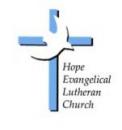|
A Look at Hope welcomes you to Hope Lutheran. Read about the history of our church. We look forward to worshiping with you at Hope Lutheran at 2:00 PM on Sunday. Worship for the summer months will be at 11:30 am starting June 2, 2019. Until then, please take a look around.
|
|
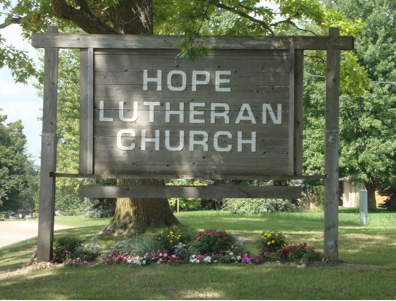
THE CHURCH SIGN
The church sign is out in the yard – not behind the church doors. It is a roadside display identifying the church – indicating the presence or existence of something else. It’s the English equivalent of the Latin word signum (token or image).
One of the most famous signs in the Bible is the rainbow. God calls it the sign of the covenant between him and the earth. He says, “Whenever I bring clouds over the earth and the rainbow appears in the clouds, I will remember my covenant between me and you and all living creatures of every kind. Never again will the waters become a flood to destroy all life.” The rainbow reminds us of God’s judgment – but also of his promise.
And there is the beloved sign of the Christmas angel, “I bring you good news of great joy that will be for all the people. Today in the town of David a Savior has been born to you; he is Christ the Lord. This will be a sign to you: You will find a baby wrapped in cloths and lying in a manger.” Here the baby lying in a manger reminds us of God’s promise – and especially of his mercy.
The letters on our church sign identify us as HOPE LUTHERAN CHURCH. Each word points to something spiritual that you’ll find inside the church.
Proclaiming HOPE is our mission. Christians are to be prepared to give “the reason for the hope that you have.” We believe in God’s judgment – the wages of sin is death. Yet we also have the confident hope that the gift of God is eternal life in Christ Jesus our Lord. Like the rainbow HOPE reminds us of God’s judgment – but also of his promise.
LUTHERAN identifies us as members of the Christian Church who cherish the truth “it is by grace you have been saved, through faith—and this not from yourselves, it is the gift of God—not by works, so that no one can boast” (Ephesians 2:8-9). Like the baby lying in a manger LUTHERAN reminds us of God’s promise – especially of his mercy.
And CHURCH (from Greek kyriakon “of the Lord”) identifies us as God’s children. Christians are entrusted with God’s word, baptism, and the Lord’s Supper. These are the means of grace God has given his CHURCH to make disciples (followers) of all nations.
The HOPE LUTHERAN CHURCH sign is an invitation made by members like Dick Seldon (his friend donated expensive cedar wood), Kim Korroch (lettering) and her dad Martin (80-100 hours with a router), John Leyrer (sturdy posts), Lyle Avery (lighting), and Margarete Preston (flower garden). But it is especially an invitation from Jesus himself, “Come to me, all you who are weary and burdened, and I will give you rest.”
|
|
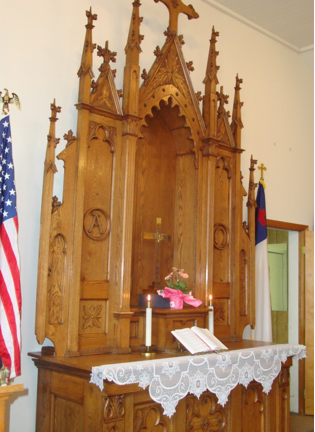
THE ALTAR
The beauty of the altar may catch your eye when you walk through the church doors. It is the stone or wooden structure located front and center in a church’s worship area.
Altar is pronounced – and sometimes misspelled – just like “alter” (to change). The term altar is taken from the Latin word altus (high) – as in altitude (height). The altar (high place) area is often raised a step or more above the rest of the worship area.
Men like Noah, Abraham, Isaac, and Moses – even judges and kings like Gideon, Saul and David – built altars out of uncut stones. There they made sacrifices and offered prayers. The Bible called their worship an “aroma pleasing to the LORD.”
For fifteen hundred years God’s people worshiped at two metal altars. The altar of burnt offering – think grilling out – was made of bronze. Here worshipers often shared in a meal consisting of bread, wine, and some of the meat from their sacrifice.
The other altar was inside God’s house – first called the Tabernacle and later the Temple. The priests brought the prayers for God’s people before this golden altar of incense.
Christians speak of their church building as God’s house. The altar is still the focal point for their prayers. (That’s why the pastor turns to face the altar when prayers are said.)
Sacrifices are no longer offered upon the altar. That is because “we have been made holy through the sacrifice of the body of Jesus Christ once for all” (Hebrews 10:10). Jesus’ death upon the cross is the sacrifice made once for all people.
Often a gold or silver cross rests in the center of the altar. It reminds us all of the precious blood Christ shed when he rescued us from the curse of our sins.
Similar to God’s people of the past, Christians often come before the altar to participate in a sacramental meal called Holy Communion or the Lord’s Supper. The altar is where the elements of this holy meal are consecrated (set apart for holy use).
Yes, the beauty of the altar may catch your eye, but its beauty goes beyond appearance. It is the place where your soul lifts up its prayers to God. It is the place where God grants the forgiveness of sins through the body and blood of his Son Jesus. The altar is where God and his people commune.
|
|
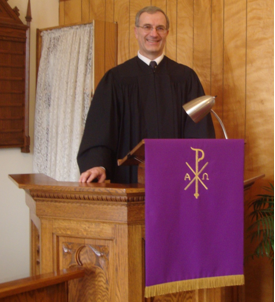
THE PUPLIT
The pulpit is also likely to catch your eye when you walk through the church doors. It is the elevated platform or reading desk used for preaching. The pulpit stands off to one side. It won't block your view of the altar, and is often built of matching stone or wood.
Pulpit is sometimes promounced "PULL PIT" - especially in the southern part of the United States called the Bible Belt. In the northern part of our country you are more likely to hear it pronounced "PULL putt." The term pulpit is taken from the Latin word pulpitum (platform or stage). You can see how similar this is to our English word.
The reason a preacher stands on an elevated platform is simply so that he can be heard. (This was especially important before the days when microphones and speakers became standard parts of the public address systems now used in many churches.)
Jesus' disciple Peter had to preach the old fashioned way. On Pentecost Peter stood up with the Eleven, raised his voice and addressed the crowd: "Fellow Jews and all of you who live in Jerusalem, let me explain this to you; listen carefully to what I say."
The most famous sermon of all was preached from the side of a mountain. Matthew tells us that when Jesus "saw the crowds, he went up on a mountainside and sat down. His disciples came to him, and he began to teach them."
The message of a preacher is known as a sermon - from the Latin word sermo (speech or conversation). The preacher generally speaks somewhere between fifteen and twenty-five minutes. And if you ever hear someone tell you, "My preacher always says the same thing," he may be letting slip that he's only heard one sermon.
Over 300 parts of the Bible are publicly read and preached on. It can easily take nine years before your preacher will actually have a second sermon based on teh same Scripture reading. Yet there are a couple things you should be able to find in every sermon. They are called the law and the gospel.
The law tells us what God expects. Yet time and again the Scriptures show how people fall short of God's expectations. Christians call this sin. And God won't put up with it. In fact sin is the reason death came into the world. And no one escapes death.
The gospel tells us what God has done about sin. "God so loved the world that he gave his one and only Son, that whoever believes in him shall not perish but have eternal life" (John 3:16). Both our need for a Savior and the good news that God has sent hs Son Jesus to be our Savior should be a part of every sermon.
|
|
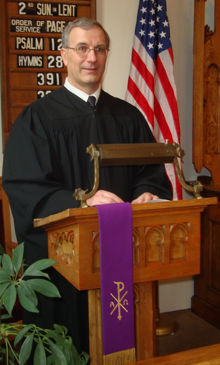
THE LECTERN
The lectern is to be found across from the pulpit when you walk through the church doors. It’s a stand used to support a book in a convenient position for a standing reader. This is where the Scripture lessons are read from during the church service.
Lectern is pronounced just the way it’s spelled and gets its name from the Latin word lector (reader). To help remember its name, think of a teacher standing at the “lectern” delivering a “lecture.” Since the lectern is often located on your left you could also think of your eyes making a “left turn” to see the reader at the “lectern.”
The public reading of the Scriptures has been part of the worship of God’s people for thousands of years. During the time of Jesus men of the congregation would stand to read from the Law and the Prophets. After the selection from the Prophets was read the speaker would sit down to teach how this prophecy pointed ahead to the coming Christ.
Jesus did this once in his hometown Nazareth: On the Sabbath day he went into the synagogue, as was his custom. And he stood up to read. The scroll of the prophet Isaiah was handed to him. Unrolling it, he found the place where it is written: “The Spirit of the Lord is on me, because he has anointed me to preach good news to the poor. He has sent me to proclaim freedom for the prisoners and recovery of sight for the blind, to release the oppressed, to proclaim the year of the Lord’s favor.” Then he rolled up the scroll, gave it back to the attendant and sat down. The eyes of everyone in the synagogue were fastened on him, and he began by saying to them, “Today this scripture is fulfilled in your hearing” (Luke 4:14-21).
Today Christian churches often have three Scripture lessons – usually one reading from the Old Testament, one from the New Testament Epistles (Letters), and one from the Gospels. The Old Testament lesson usually points ahead to events fulfilled in the New Testament Gospel or Epistle lessons.
The readings are selected to fit with the thoughts of the church year. From December through May they tell of the life of Christ – his coming (Advent), his birth (Christmas), his appearing (Epiphany), his suffering and death (Lent), his resurrection (Easter), his return to heaven (Ascension), and his sending of the Holy Spirit (Pentecost).
From June through November the readings remind Christians: God’s Word is our great heritage And shall be ours forever; To spread its light from age to age Shall be our chief endeavor. Through life it guides our way; In death it is our stay. Lord, grant, while worlds endure, We keep its teachings pure Throughout all generations (Christian Worship, Hymn 293).
|
|
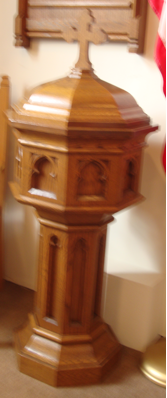
THE BAPTISMAL FONT
The baptismal font may be found near the front of the center aisle – especially in a church built in recent years. In an older church you’ll probably find the font tucked off to the side near the lectern. The font is a receptacle for the water used in baptism.
Font is easier to pronounce than it is to spell. The term comes from the Latin word fons (fountain or source). English writers may want to spell it “fount” rather than “font.” But the Latin spelling – used for centuries by many western Christian churches – is correct.
The baptismal font usually has a cover with a cross on top. Once the cover is removed you’ll see a bowl that is filled with water for baptism. The height is just right for adults to lean over with an infant child in their arms. That’s when the pastor applies the baptismal water “in the name of the Father and of the Son and of the Holy Spirit.”
Saint Paul gives us a wonderful description of baptism, “God saved us through the washing of rebirth and renewal by the Holy Spirit, whom he poured out on us generously through Jesus Christ our Savior, so that, having been justified by his grace, we might become heirs having the hope of eternal life” (Titus 3:5-7). Clearly baptism is the work of the Father and of the Son and of the Holy Spirit.
Traditionally the font has an octagon shape. (Six sides for the six days of creation – the Father’s work – the seventh side for the day of rest – found in the work of the Son – and the eighth side for the covenant between God and his children – the Holy Spirit’s work.)
In Old Testament times “the eighth day” was when infant sons were circumcised. This covenant (promise) pointed ahead to the Savior. In New Testament times baptism points to this promise fulfilled by Jesus’ life and death. Christians speak of being “baptized in the name of Jesus Christ” because Jesus’ work is credited to the one being baptized.
In Christian homes where infants are baptized these children continue to be instructed in the teachings of God’s word throughout their lives. They grow up knowing that they are God’s children and will go to heaven to be with him when they die. This is true because their sins have been washed away in Jesus Christ.
In homes where children have not been baptized instruction in God’s word comes before baptism. Then – rather than create faith as in infant baptism – baptism strengthens faith. Baptism is a sacrament (holy means) that works forgiveness of sin, delivers from death and the devil, and gives eternal salvation to all who believe.
Jesus has entrusted this precious treasure – a means of grace – to his church.
|
|
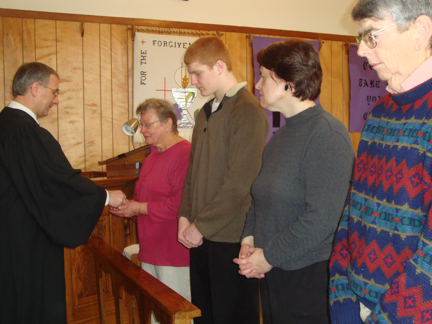
THE COMMUNION RAIL
Is a communion rail just for decoration, or does it have a special purpose? The communion rail is a bar extending from one post or support to another. It serves as a guard or barrier between the chancel (altar area) and the nave (main area).
The word communion comes from the Latin word communio (mutual participation). Rail – like Middle English raile – comes from the Latin word regula (straight board). So how does this “barrier” serve to demonstrate “mutual participation”?
Church members humbly kneel – or stand – before the communion rail to receive the Lord’s Supper. The rail reminds God’s people that their sins separate them from God. The setting is similar to when the LORD warned his people at Mount Sinai, “Put limits around the mountain and set it apart as holy.”
Yet at Mount Sinai the LORD called the Israelites to be his people. At the communion rail the bread and wine – together with the body and blood of Jesus – is extended across the barrier. As members participate in the Lord’s Supper they receive the forgiveness of sins, life, and salvation – God’s blessings to his children.
Of course all this is a great mystery of God. How can Jesus’ body and blood be present together with the bread and wine? How does this meal grant the forgiveness of sins and strengthen the faith of whose who receive it?
Unfortunately people who create “answers” to these mysteries end up replacing the simple truths of God’s word with their own ideas. God intends the Lord’s Supper to be an extremely personal application of his mercy and grace. He does not want it to be diminished – for anyone – to a church ritual or bare symbol.
You can read about the Lord’s Supper in Matthew (chapter 26), Mark (chapter 14), and Luke (chapter 22). The apostle Paul also writes about it in 1 Corinthians: The Lord Jesus, on the night he was betrayed, took bread, and when he had given thanks, he broke it and said, “This is my body, which is for you; do this in remembrance of me.” In the same way, after supper he took the cup, saying, “This cup is the new covenant in my blood; do this, whenever you drink it, in remembrance of me.” For whenever you eat this bread and drink this cup, you proclaim the Lord’s death until he comes (11:23-26).
The comfort for Christians is that Jesus died for their sins and he will come again to take them to heaven. The Lord’s Supper is an intimate participation in these truths.
|
|
|
